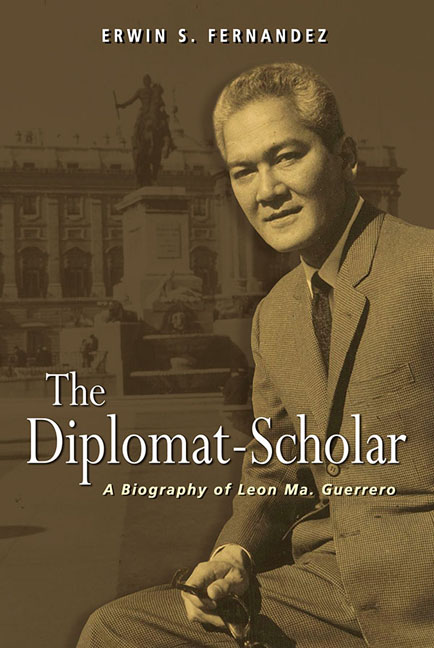Book contents
- Frontmatter
- Dedication
- Contents
- Preface
- Prologue
- Chronology
- I Ermita and Santa Cruz to Intramuros: Between Literary and Legal Career
- II To Tokyo and Back: The Making of a Diplomat
- III Going In, then Out of the Political Jungle: Padre Burgos to Arlegui
- IV London and Madrid: The Philippines in a Resurgent Asia
- V New Delhi to Belgrade: The Philippines towards Non-Alignment
- 18 Homecoming to Asia at Nehruvian India
- 19 “Diplomacy of Development” and Other Speeches
- 20 The Foreign Policy Rescuer and Again, Critic
- 21 The Diplomat as Efficient Intellectual-Bureaucrat
- 22 Endorsing Non-alignment amid Personal Crisis
- 23 Flirting with Dictators
- 24 Martial Law Propagandist
- 25 At Tito's Pre-Balkanized Yugoslavia
- Epilogue
- Glossary
- List of Abbreviations
- Bibliography
- Index
- About the Author
25 - At Tito's Pre-Balkanized Yugoslavia
from V - New Delhi to Belgrade: The Philippines towards Non-Alignment
Published online by Cambridge University Press: 12 January 2018
- Frontmatter
- Dedication
- Contents
- Preface
- Prologue
- Chronology
- I Ermita and Santa Cruz to Intramuros: Between Literary and Legal Career
- II To Tokyo and Back: The Making of a Diplomat
- III Going In, then Out of the Political Jungle: Padre Burgos to Arlegui
- IV London and Madrid: The Philippines in a Resurgent Asia
- V New Delhi to Belgrade: The Philippines towards Non-Alignment
- 18 Homecoming to Asia at Nehruvian India
- 19 “Diplomacy of Development” and Other Speeches
- 20 The Foreign Policy Rescuer and Again, Critic
- 21 The Diplomat as Efficient Intellectual-Bureaucrat
- 22 Endorsing Non-alignment amid Personal Crisis
- 23 Flirting with Dictators
- 24 Martial Law Propagandist
- 25 At Tito's Pre-Balkanized Yugoslavia
- Epilogue
- Glossary
- List of Abbreviations
- Bibliography
- Index
- About the Author
Summary
It took five years for the Philippines to finally establish a permanent mission in Belgrade since 1972 when an exchange of letters was made between the two governments. The Yugoslav Government in 1973 accredited their Tokyo ambassador as non-resident envoy to the Philippines. After two years, they decided to send a resident ambassador to Manila. From 1972 until Guerrero's arrival in Belgrade in November 1976, there were several diplomatic engagements between the Philippines and Yugoslavia such as the signing of an agreement on waiver of non-immigrant visa requirements in Manila; Romulo's visit to Belgrade; visits to Manila of a member of the Federal Executive Council; a minister of economy and head of the Yugoslav delegation to the Third Ministerial Meeting of the Group of 77, a federal secretary for Finance and the governor of the National Bank of Yugoslavia.
The Yugoslav Government leased a terrace-type building to house the Philippine Embassy and the ambassador's residence. Guerrero was accepted as Philippine ambassador by the Yugoslav government in early January 1977. A few days after, four Yugoslav football specialists arrived in Manila to provide training to more than fifty coaches under the FIFA Coca Cola World Football development programme. From reading English newspapers that had to come all the way from Paris, he learned that Yugoslavia was reeling from an economic crisis. By the end of 1976, the World Bank had loaned more than US$1 billion to Yugoslavia followed by another US$1 billion in two loans in February 1977. In the middle of this uncertainty, he had to come home in March to attend the funeral of de la Costa who died from liver cancer.
FULFILLING A REQUEST
Guerrero attended the funeral in Novaliches to pay his last respects to his best friend. After the funeral, he went to Chitang's house in San Juan. Chitang could not forget that afternoon: “His face had darkened several hues and his eyebrows were knit over downcast eyes. Gone was the sunny smile. His shoulders drooped and he seemed to be dragging his feet to the couch in my living room. We sat together wordlessly for a long time, sunk in sorrow, digesting the fact that, both he and I, had lost someone who was, for us, the best creature to have walked this earth.”
- Type
- Chapter
- Information
- The Diplomat-ScholarA Biography of Leon Ma. Guerrero, pp. 288 - 294Publisher: ISEAS–Yusof Ishak InstitutePrint publication year: 2017

